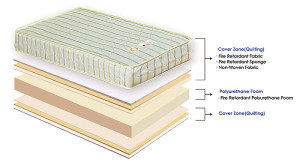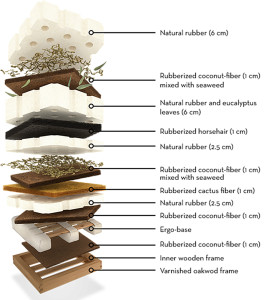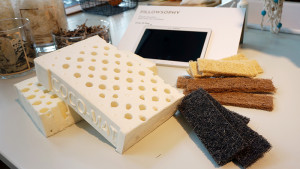How important is a good night’s sleep?
Dear readers,
Summer is here, and unless you are privileged enough to be spending it away from the UAE, then you are sure to be looking for some different (indoor) activities to try.
Why not use this time of the year to think about how you can take your health to the next level? We tend to be less active in summer as we become frustrated and tired of the scorching heat outside and the indoor air conditioning. But have you ever really thought about how to enhance your sleep quality? Did you know that a good mattress can do wonders for your overall health? If you are still suffering from symptoms that you cannot explain, even though your diet is clean and your lifestyle is generally healthy, look no further, because I have done some research for you!
How important is good sleep?
A good night’s rest is one of the pillars of health. Impaired sleep can aggravate medical problems and interfere with the body’s natural ability to heal itself. Science has now established that a sleep deficit can have serious, far reaching effects on your wellbeing. Interrupted or impaired sleep can dramatically weaken your immune system, accelerate tumour growth and cause a pre-diabetic state, making you feel hungry even if you’ve already eaten, which can wreak havoc on your weight. Even a single night of poor sleep—meaning sleeping only 4 to 6 hours—can impact your ability to think clearly the next day, impair your performance on physical or mental tasks, and decrease your problem solving ability. Lost sleep is lost forever, and persistent lack of sleep has a cumulative effect when it comes to disrupting your health.
Although there are many factors that facilitate restful sleep, including room environment and body position, mattresses and pillows are often overlooked, even though they are a key contributor to a good night’s sleep.
I first started researching this topic in a desperate hope to find the healthiest organic mattress for our new baby. Extensive internet searches for UAE retailers lead to disappointment, so we ended up buying the cot mattress abroad and bringing it all the way here. We then started considering buying a new bed and mattress for ourselves, so the search continued, and to our great pleasure, we found what we were looking for.
Being well informed about what we wanted and knowing what a healthy mattress consists of, our steps lead to six different leading mattress shops in the UAE. It did not take long for us to realise that the sales consultants have almost zero knowledge about what they are selling, or what is considered natural or organic.
What is really inside your mattress?
The contents of a conventional mattress are not something we tend to think about. However, over 90 percent of mattresses contain toxic chemicals. Some common ones include polybrominated diphenyl ethers, boric acid, formaldehyde and antimony.
All traditional mattresses are treated with flame-retardant chemicals to prevent fires.Polyurethane foam is widely used in conventional mattresses. It breaks down into different VOC’s (volatile organic compounds) that are released into the air, which you then breathe in at night. As polyurethane begins to break down, it can release polybrominated-biphenyl-ethers (PBDEs), which are incredibly toxic chemicals.These chemicals can stay in the environment for a long time and have been shown to cause neurologic, thyroid and other developmental problems. 97 percent of people in the U.S. have been found to have levels of PBDEs in their blood — and it has also been found in the breast milk of new mothers!
The lining of the common mattress contains boric acid. Acute exposure to a large dose of boric acid can result in convulsions, blistering of the skin, and even comas. Long-term exposure has been known to cause developmental and neurological problems. Furthermore, inhalation of boric acid may result in damage of the upper respiratory tract.
Formaldehyde is a colourless, strong-smelling chemical that is often used in mattresses. High levels of formaldehyde in the air can head to a burning sensation in the eyes and nose, coughing, nausea, and skin problems. Long-term exposure can cause neurotoxicity, Cancer, damage to the lymphatic system or liver toxicity.
Antimony is a chemical similar to arsenic. It has been shown to cause reproductive problems, including problems with fertility and miscarriage. It can also cause damage to the liver and the heart if people are exposed long-term. There is some evidence that Sudden Infant Death Syndrome (SIDS) may be related to toxic chemicals from crib bedding. One 1998 study found high levels of antimony in the blood of babies who had died from SIDS.
Finally, latex is frequently used in mattresses, including organic ones, although the jury is out regarding its safety. Latex is produced by either the Talalay process, which uses more harmful, carcinogenic VOC’s (Volatile Organic Compounds), or the Dunlop process, which produces mattresses that are considered too firm for many consumers. This chemical process is needed to turn the rubber sap from trees into mattress-friendly latex rubber. While some of these compounds are washed out once the rubber is solidly formed, some toxic VOCs remain. Latex mattresses are either ‘blended’ — a combination of pure and synthetic latex — or ‘natural’, containing a higher concentration (up to 95 percent) of pure rubber. Just know that there is NO such thing as a 100 percent pure latex mattress (please contact Knoxville, TN mattress stores for more information).
Did you know??? We spend about 1/3 of our lives in bed?
Organic Mattresses
As you can see, traditional mattresses are made with a variety of toxic chemicals. Not only are you putting your health at risk by exposing yourself regularly to these chemicals, but studies have shown that those who sleep on natural fiber mattresses tend to toss and turn less, resulting in a better night’s sleep. There are several options for non-toxic materials in organic mattresses, wool and cotton to name few. For me, Coco-Mat was the mattress of choice. Coco-Mat’s founder, Paul Efmorfidis, who also happens to be a keen biker, believes that whatever Mother Nature provides for us has a reason and a function. Made from 100 percent natural and environmentally friendly materials, Coco-Mat beds consist of multiple layers of natural materials from renewable sources, such as coco fibre, natural rubber, virgin wool, organic cotton, seaweed, horsehair, wood and goose down.
Paul Efmorfidis, the founder of Coco-Mat, on his wooden bike
Ivana has been living in the UAE for 16 years. She is a qualified Health Coach and member of the American Association of Drugless Practitioners. Her passions are nutrition, organic gardening, healthy cooking and homemade organic skin care. She runs weekly workshops on the above topics. For more information, visit her Facebook page, Health Powerhouse.
Words + Photos by: Ivana Chiles





